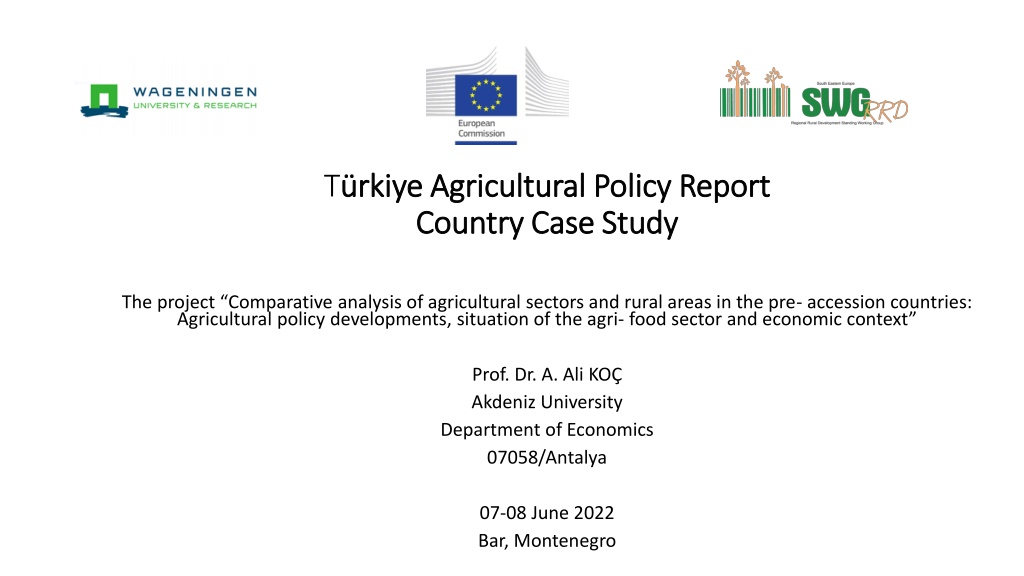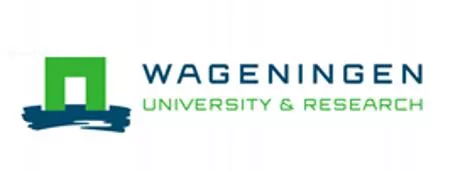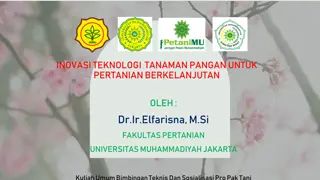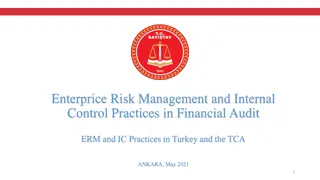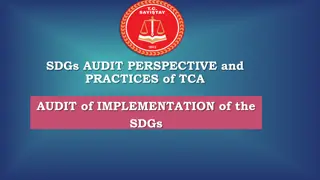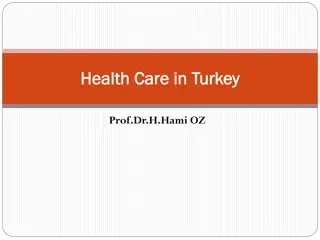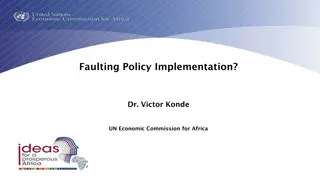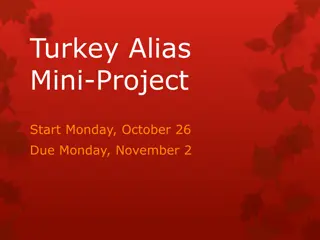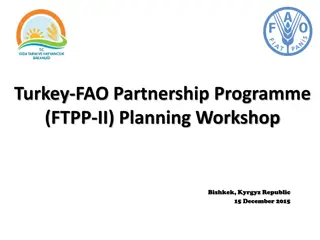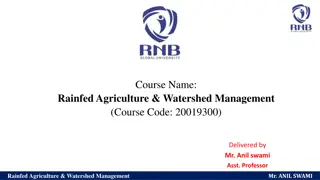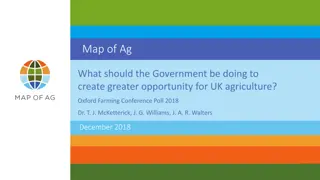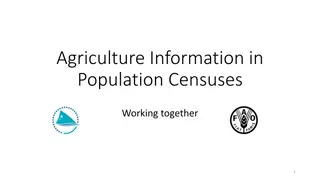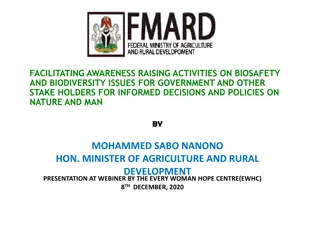Agriculture in Turkey: Policy, Development, and Challenges
Agriculture in Turkey plays a significant role in the country's economy, with various policies and measures aimed at enhancing productivity, sustainability, and adaptation to climate change. The government has implemented new subsidy programs to support strategic crops and livestock, encouraging diversification and increased productivity. This report provides insights into the structural and socio-economic indicators of agriculture in Turkey, as well as an analysis of agricultural support policies and their impact on the sector.
Download Presentation

Please find below an Image/Link to download the presentation.
The content on the website is provided AS IS for your information and personal use only. It may not be sold, licensed, or shared on other websites without obtaining consent from the author.If you encounter any issues during the download, it is possible that the publisher has removed the file from their server.
You are allowed to download the files provided on this website for personal or commercial use, subject to the condition that they are used lawfully. All files are the property of their respective owners.
The content on the website is provided AS IS for your information and personal use only. It may not be sold, licensed, or shared on other websites without obtaining consent from the author.
E N D
Presentation Transcript
Tr rki kiye yeAgricultural Agricultural Policy Country Case Study Country Case Study Policy Report Report The project Comparative analysis of agricultural sectors and rural areas in the pre- accession countries: Agricultural policy developments, situation of the agri- food sector and economic context Prof. Dr. A. Ali KO Akdeniz University Department of Economics 07058/Antalya 07-08 June 2022 Bar, Montenegro
Outline Outline Introduction Agricultural Policy: Objectives, Strategic Plan and Measures National Rural Development Strategy Key Legal, Strategic and Programming Document New Policy Instruments/Measures Introduced in 2020 and 2021 Adaptation to Climate Change Greener Policy Instruments and Measures Legal Arrangements Concerning the EU approximation Conclusions
Introduction: Structural Indicators of Agriculture in Turkey Turkeys total land area is 78.35 million hectares, of which approximately 1.4 million is covered with dams, ponds, etc. Total utilized agricultural area is 30.1 million hectare, consist of 23.5 million hectare arable and permanent cops and 14.62 meadows-pasture, Annual plants cover 85% of the agricultural land and perennial plants occupy 15% of the agricultural land. Field crops account for 67.5% of the arable land and 14% left as fallow land. Irrigated area reached 6.7 million hectares. Of this amount, 4.41 million hectares have a modern irrigation network
Introduction: Socio-economic Indicators of Agriculture in Turkey Primary agriculture sector employs 17.2% of the workforce (ranging from 18.4% in August to 14.6% in December in 2021) Accounts for 5.65 % of GDP in 2021. Turkey is a net exporter f agricultural and processed food Products (including beverage and tobacco) which accounts about 11% of total exports (USD 225.3 billion) and 7.7 % of total import (USD 271.4 billion) in 2021. Primary products account for around 62% of total agro-food imports. Processed products account for about 70% of total agro-food exports
Agricultural Support Policies in Turkey The government of Turkey has started a new agricultural subsidy program in 2017, which covers a new subsidy budget allocation system for agricultural domestic supports measure for 19 strategic crops (determined by government) and livestock. One of the focus in this new program is to diversify agricultural production, increase productivity and reduce the planted area of water-intensive crops in draught prone areas. Within this scope, the country is divided in 941 agricultural basins, based on climatic conditions and soil characteristics to subsidize specific crops for each zone. As part of the new program, Turkish Grain Board is not allowed to procure crops through intervention buying if they are not on the subsidized crop list of their specific agricultural basin
Agriculture Policy Objectives in Turkey The Eleventh Development Plan covering 2019-23 delineated the main agricultural policy objective as; to develop an efficient agricultural sector that is environmentally, socially and economically sustainable, which is in line with the EU agricultural policies. An adequate and balanced food supply should be provided, advanced technology is employed and international competitiveness should be strengthened. For this objective, a number of targets and measures are set to be achieved by 2023. Among the targets are increased production of oilseeds and red meat, use of irrigation and land consolidation, pasture reclamation and land management area are some of the targets to be achieved in the plan.
Strategic Plan for Agriculture in Turkey The Ministry (MoAF) developed a Strategic Plan for 2019-23, which is in line with the 11. Development Plan. The objective of the 2019-2023 Strategic Plan of the Ministry are to increase the welfare of rural people, to ensure a stable food supply by increasing the yield and quality in agricultural production. reducing rural to urban migration, improving access to finance for small farmers and cooperatives, small businesses, decreasing the rural poverty by diversifying alternative income methods such as inland fisheries, handicraft works, agro-based industry and rural tourism.
Objectives of Strategic Plan (2019-2023) for Agriculture in Turkey to Increase economic welfare in rural areas, ensuring food supply by increasing yields and quality, to ensure food and feed safety taking into account for plant and animal health and animal welfare, to protect aquaculture and fisheries resources, to ensure sustainable management of land and water resources, to efficiently combat climate change, desertification and erosion, to protect biodiversity and to improve institutional capacity.
Agricultural Policy Trends of Turkey Agricultural Policy Trends of Turkey ( (Source: OECD, 2021 Source: OECD, 2021) ) Period Broader framework Changes in agricultural policies Highly closed economy in Agriculture (import substitution regime) Prior to 1980s 1. 2. 3. 4. 5. 6. 7. High tariffs for border protection Agricultural price controls Input subsidies Import controls by the State Economic Enterprises which controlled agricultural marketing and production Agricultural Sales Co-operatives Unions (ASCU) and agricultural member cooperatives (ASC) Agricultural Credit Cooperatives State-owned Agricultural Bank Gradual reform to liberalize trade but with agricultural protection 1980-2010 1. 2. 3. 4. 5. 6. 7. 8. 9. 10. Introduction of agri-environmental policies and cadastral works 11. Free Trade Agreements (FTAs) signed Agricultural Reform Implementation Project (ARIP) as a precondition of the World Bank and IMF programs Privatization of SEEs and restructuring of ASCUs Price-fixing by government discontinued for some products but remains for others Gradual reduction of tariffs for some agricultural inputs and outputs Progressively reduced role for ASCUs and ASC Price controls continued Product and input subsidies phased out Introduction of Direct Income Support Compensatory payments to cover the cost of switching from crops in excess supply Open market economy but with agricultural protection 2010-present 1. 2. 3. 4. Agricultural tariffs continue to be used Export subsidies implemented Deficiency payments differentiated according to 30 agricultural basins throughout the country Infrastructure investments increased
Measures and Budgetary Support of Agriculture and Rural Development Measures and Budgetary Support of Agriculture and Rural Development Given its economic and social role in the Turkish economy, together with a national goal of enhancing food self-sufficiency and food security, the agricultural sector has long been a subject to government support and interventions. Total agricultural supports budget (includes all types of domestic supports measures) based on data obtained from Ministry of Treasury and Finance (Central Government Budget Expenses), except agricultural credits subsidy, decreased from 0.60 to 0.33 percent of GDP between 2006 and 2021. Agricultural support budgets and agricultural credit subsidies together were 0.40 percent of the Turkish GDP in 2021.
Budgetary Cost of Support Measures (Million ) 4.5 4.0 3.5 3.0 2.5 2.0 1.5 1.0 0.5 0.0 2006 2007 2008 2009 2010 2011 2012 2013 2014 2015 2016 2017 2018 2019 2020 2021
National Rural Development Strategy for 2014-2020 Turkey adopted the 2014-20 National Rural Development Strategy in 2014 to deliver the EU Instrument for Pre-Accession Assistance Rural Development (IPARD-II). These rural development projects require co-financing of beneficiaries, with the aim of mobilizing private sector resources. Public investments to improve agricultural infrastructure are targeted to boosting agricultural production and increasing the competitiveness of the sector. Strategic objectives of the NRDP are improving the rural economy and increasing employment opportunities, improving the rural environment and ensuring the sustainability of natural resources, development of social and physical infrastructure of rural settlements, development of human and social capital of rural society and poverty reduction and development of institutional capacity for local and rural development.
National Rural Development Strategy for 2021-2023 The Ministry declared the new National Rural Development Strategy (NRDP) : 2021-2023. The main objectives of rural development policy are to increase the employability of producer associations and family enterprises with the understanding of sustainable rural development, to improve the quality of life, to reduce poverty, to increase the welfare level of the rural community by providing regular and adequate income opportunities, to ensure, develop and sustain the living of the population in the rural area
Overview of the Measures, Funds and Number of Applications in IPARD 2014 Overview of the Measures, Funds and Number of Applications in IPARD 2014- -2020. 2020. Indicator1 M1 M3 M4 M7 M9 Total No. of applications 1 241 665 92 4 660 32 6 690 No. of approved applications 901 591 92 4 158 32 5 774 EU contribution (th. EUR) 123 070 99 606 1 806 134 204 710 359 397 National contribution (toushand EUR) 41 023 33 202 319 44 735 125 119 404 Total payment (th. EUR) 164 093 132 808 2 125 178 939 835 478 801 EU allocated amounts (toushand EUR)2 200 740 153 100 3 720 213 800 7 680 579 040
National Rural Development Strategy National Rural Development Strategy for 2021 for 2021- -2027 ( 2027 (IPARD IPARD- -III Program III Program) ) Measures, specifically taking into account of the "Rural Infrastructure and Renewable Energy" approaches, of the IPARD Program are the following : Investments in the establishment of agricultural enterprises producing milk, red meat, poultry meat, and eggs, Investments in the processing and marketing of milk, red meat, poultry meat, aquaculture, and fruit and vegetable products, Investments in the diversification of vegetable production; processing and packaging of herbal products; production, processing, and packaging of beekeeping and bee products, crafts and local product enterprises; aquaculture; rural tourism and recreational activities; machinery parks and renewable energy, Implementations for agriculture, environment, climate and organic agriculture (Prevention of soil erosion, protection of groundwater resources, protection of biodiversity), The implementation of local development strategies Projects (LEADER), Rural infrastructure investments, Establishment of producer organizations, Development of education and technical assistance, Development of consultancy services.
Key Legal, Strategic and Programming Document Key Legal, Strategic and Programming Document Key legal, strategic and programming document Key goal and objectives Notes/remarks The law aims to develop and implement the necessary policies to improve the agriculture and rural areas in accordance with the development plans and strategic papers Law on agriculture Adopted in 2005 The Eleventh Development Plan presents a long-term perspective based on the vision of stronger and more prosperous Turkey that produces more value added and shares more fairly Agriculture. The main objective is to create an efficient agricultural sector that is environmentally, socially and economically sustainable, internationally competitive with its production structure that considers supply and demand balances as well as adequate and balanced nutrition of the people Adopted for 2019- 2023 11th Development Plan The aim is to develop plans for the sector. Actions to be taken are i) Agricultural production and supply security, ii) Food safety, iii) Rural development and marketing, iv) Fisheries and aquaculture, v) Soil and water resources, vi) Biological diversity and climate change, vii) Forest, and viii) Institutional capacity. Council specifically addresses that agricultural policies will be designed using a holistic approach by taking into account of the principles of the sustainability for at least five-year period based on the development plans. 3rd Agriculture and Forestry Council Adopted for 2024 National Strategy for Agriculture and Rural Development 2019- 2023 NRDS aims to determine correctly the development dynamics of rural areas that fall relatively behind the national welfare level and to mobilize the economic and human resource potential in these areas within the framework of the determined strategies. Adopted for 2021- 2023 Adopted 2021- 2027 IPARD 2021-2027 IPARD III aims to improve the rural vitality to invest in agriculture and related areas. Presidency Decision aims to increase the competitive capacity of the sector, productivity and quality, develop new technology with national recourse, protect the genetic resources, apply environmentally friendly agricultural practices and to boost the efficiency of the agricultural policies for ensure the agricultural production and supply security. Adopted in 2020 and 2021 for fertilizer and certified seed use National Program for Agricultural Support Policy
New Policy Instruments/Measures Introduced in 2020 and 2021 New Policy Instruments/Measures Introduced in 2020 and 2021 Crop Production Improvement Project implemented to ease the Covid-19 cconsequences. This project aimed at accelerating, planting in 24 provinces, at least preventing the crop looses. As a result, crop production increased in cereals. Instrument/ programme New measure and policy significance Year of introduction Drought payment To compensate the income loss of farmers due to the drought in 2021 2021 Additional payment for the fertilizer To increase due to the increase in input price for wheat, barley, oat, rye and triticale compensate the cost 2021
Adaptation to Climate Change Turkey Agricultural Drought Strategy and Action Plan , 2018-22, was approver to Combat Agricultural Drought. The main pillars of the Action Plan are to develop a capable institutional structure and making the agricultural sector more resilient to drought. Activities in the Action Plan are grouped under five categories : i) drought risk estimation and crisis management, ii) ensuring a sustainable water supply, iii) effective management of agricultural water demand, iv) increasing support to R&D activities, training and extension services, and v) institutional capacity building (OECD, 2020).
Greener Policy Instruments and Measures Greener Policy Instruments and Measures The Ministry of Trade prepared the Green Deal Action Plan of Turkey. Action Plans mainly aims to establish Turkey's compliance with the European Green Deal in order to contribute to Turkey's transition to a more sustainable, resource-efficient and green economy. The Green Deal Action Plan determined the goals are as follows : Limiting carbon emissions, A green and circular economy, Green financing, A clean, economic and safe energy supply, Sustainable agriculture, Sustainable smart travels, Combatting against climate change, Establishing diplomacy principles and Raising awareness regarding European Green Deal. The Action Plan covers 32 target and 81 action to be taken.
Agriculture Contribution to GHG and the Paris Agreemen Agriculture Contribution to GHG and the Paris Agreement Turkey is a signatory to the Paris agreement. Agriculture represents 7.3% of total greenhouse gas (GHG) emissions in the country. Turkey s Nationally Determined Contributions (NDCs) to the 2016 Paris Agreement aims to reduce emissions by up to 21% compared with business as usual projections by 2030. There are no specific targets for agriculture and no current policies designed exclusively to reduce emissions from agriculture. However, in its Nationally Determined Contributions (NDCs), Turkey proposes to reduce agricultural emissions through fuel savings resulting from consolidation of agricultural land, rehabilitation of grazing lands, controlling fertilizer use, implementation of modern farming practices and encouraging use of minimum tillage farming techniques. Environmental Indicators in Turkey are given in Table below (next slide).
Environmental Indicators in Turkey. Environmental Indicators in Turkey. Turkey OECD Average Indicators 2000* 2018* 2000* 2018* Nitrogen balance, kg/ha 27.8 27.7 33.3 29.1 Phosphorus balance, kg/ha 8.0 7.0 3.3 2.3 Agriculture share of total energy use (%) 5.0 3.3 1.7 2.0 Agriculture share of GHG emissions (%) 14.1 11.9 8.1 8.9 10.3 Share of irrigated land in total AA (%) 8.0 - - 85.2 Share of agriculture in water abstractions (%) 75.4 46.0 49.0 Water stress indicator 18.6 25.4 9.9 8.9
Agriculture and Environmental Protection The Ministry of Agriculture and Forestry developed a monitoring systems in which the priorities are identifying agricultural areas sensitive to erosion and applying erosion control methods more effectively in these areas, efficient use of renewable energy, reducing erosion by extending methods such as terracing and planting, updating the national basic soil maps and accordingly preparation and follow up of land use and production plans, establishment and support of production stations for fauna.
Legal Arrangements Concerning the EU approximation Legal Arrangements Concerning the EU approximation Measure envisaged Objective By-law on the Integrated Administration and Control System Establishing an Integrated Administration and Control System, which shall ensure the management and control of farmer applications for various support schemes to be provided within the scope of EU's Common Agricultural Policy, and determiningthe cross compliance rules Amending the Law No.1163 on Cooperatives (OG: 10.05.1969/13195, Law No.5200 on Agricultural Producers Unions (OG:06.07.2004/ 25514, and the Law No.5957 on the Regulation of the rules and procedures of the commerce of fruits and vegetables and other goods to be determined according to their supply and demand (OG:26.03.2010/275 33) Developing an organizational structure and function in line with the EU for agricultural producer organizations in Turkey through amending existing laws or making a new legal arrangement; and establishing a system in line with EU for the recognition of the producer organizations by the competent public authority in this respect Strategy on Agricultural Supports Fulfilling the second opening benchmark of the Chapter by finalizing and presenting to the Commission the draft Strategy on Agricultural Supports drafted within the scope of ESEI project on Capacity Building and Support to the Preparation of a Regulatory Impact Assessment (RIA) for Decoupled Agricultural Support conducted under the 2013 Financial Cooperation Program Establishing Farm Advisory System (FAS) in Turkey Extending the Implementation of Local Development Strategies the LEADER approach measure under rural development programs Aligning the farm advisory system in Turkey with EU standards Improving cooperation among local actors involved in rural development under the umbrella of the Local Action Groups and strengthening local capacity for identifying development priority areas and targets by local actors Extending the implementation of agri-environment measures under rural development programs Extending the implementation of the measures by completing preparatory work related to water protection, biodiversity, organic farming, as well as ground cover management and soil erosion control, currently implemented as pilot sub-measures under the IPARD Program Increasing environmental supports for the extension of the measures to mitigate the adverse impact of agricultural activities on soil and water resources Preparing a strategy, which provides for law amendment to align the Producers Unions established pursuant to the Law No. 5553 with the European Union System and covers arrangements needed within this scope Preparing a strategy paper for the fisheries management Developing an organizational structure and function in line with the EU for agricultural producer organizations in Turkey through amending existing laws or making a new legal arrangement; and establishing a system in line with the EU for the recognition of the producer organizations by the competent public authority Aligning with the EU Common Fisheries Policy (CFP
Conclusions Turkish agricultural Policy measure has not fully aligned with the EU CAP. But, infrastructure and human capacity to implement the CAP is ready. Current Agricultural Policy objectives and measures to support agriculture are different (except, rural development Policy) even if there are many similarities.
